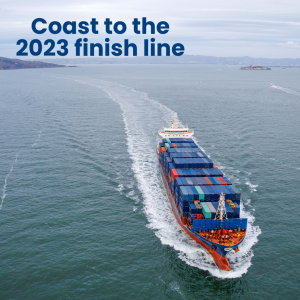 There’s no doubt that the last three years cargo shipping has been a wild ride. Anyone who’s worked in the freight forwarding business with tenure knows what’s normal versus historic. When cargo shipping makes headlines like it did over the past few years, it’s unusual.
There’s no doubt that the last three years cargo shipping has been a wild ride. Anyone who’s worked in the freight forwarding business with tenure knows what’s normal versus historic. When cargo shipping makes headlines like it did over the past few years, it’s unusual.
The 2023 finish line is ahead. And the good news is that we’re rounding the corner into the fourth quarter, with all appearances and predictions that the industry will make a strong finish. This year has been a blessing for most ocean shippers.
Rates have stabilized, general rate increases have been rare, and demand has normalized. A recent JOC.com article says, “US imports from Asia increased for the fifth consecutive month in July to 1.46 million TEUs — the highest since last September, raising the likelihood that the eastbound trans-Pacific trade will return to year-over-year import growth this fall.”
Meanwhile, spot rates, which peaked at over $12,000 for containers moving from north Asia to the US west and east coasts last year, now fall into the $3,000 range. And when containers arrive on the west coast, whether at LA/Long Beach or Canadian ports, labor union disruptions appear to be solved and congestion subsiding. For the first time in a long time truckers are looking for business and rail congestion has eased.
Make the most of a smooth finish
Carriers are rolling out new, larger vessels. The containership order book stands at 7.1 million 20-foot equivalent units (TEUs) through 2024, according to Alphaliner. The previous peak was 6.6 million TEUs in 2008. Thinking economics 101 here, more supply and stabilized demand should equal stable rates. Carriers would need to pull capacity to raise rates.
That said, don’t wait too long to start the ordering back up. Data reported in August (see above) shows exports from Asia to the United States picking up again. During the pandemic, shipping in advance to stock inventory was critical. Now it’s time to return to finding the balance in current inventory surplus with JIT supply chain operations. Airfreight remains high, so being proactive to review supply chain inventories now is important to ensure a smooth 2023 finish.
Our team continues to monitor for bumps and blips.
- Alliances: One trend we’re closely watching is the outcome of the Alliances framework. The world’s two largest carriers in the 2M Alliance, Maersk and MSC, are breaking up in 2025. There are many pundits making predictions about the impact to the Alliances system.
- Weather systems: Hurricane season continues, and we just saw an unusual situation on the west coast with a hurricane causing severe flooding in southern California. Fortunately, it didn’t impact port operations at LA/Long Beach.
Contact our team with questions or for support related to your cargo shipping.
